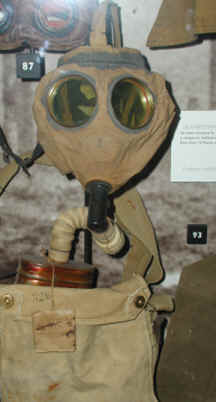May 10, 1918 – Full diary entry:
Marched 10 miles to gas test. Issued gas masks.
Wrote to Elinore and Mother.
Will stop at more Rest Camps on the way to the rear lines.
Despite being banned by international treaty, various types of chemical weapons – including chlorine, phosgene, and mustard gas – were widely used during WWI.
Scroll down to the bottom of this post for some 1918 footage of gas training – don’t miss the baseball scene at the 44-second mark.

Chaplain Edwards, From Doniphan to Verdun: The Official History of the 140th Infantry:
Our rifles were taken from us, and we were given the British Enfields. Many of the men found it hard to see the rifles they had been taught to take care of piled up and left apparently to rust. Our barracks bags were turned in also, and some of them were pillaged even before we left the camp. Only about one hundred of them ever reached the regiment. Over 200,000 are piled up in the Lost Baggage Branch, Pier 2, Hoboken, N. J. No doubt many of ours are among them. But how they can ever be distributed no one can imagine.
Here too we were fitted with English gas masks, and given instruction in their use. At first a gas mask seemed a great nuisance, but in time we came to feel a very deep affection for them. The fitting was done by British non-coms. Their instructions were clear cut and clever.
There was one Scottish sergeant whose instructions were given in a humorous strain that reminded one of Harry Lauder. But one could not tell them anything and one could not argue with them. A British non-com does the accustomed thing. He does not think. He dreads anything strange or new. And his always unanswerable reply “It simply isn’t done you know” reduces one to helplessness.
Corporal Phillips, War in Words:
At this time we were issued steel helmets and overseas caps instead of the campaign hats. Here, too, we received our gas masks and passed through the gas house to learn the value of the mask. Each day for some time we drilled on these heights and practiced putting on our masks. In a short time most everyone could put their masks on from alert position in four seconds or less. We practiced holding our breath at the sound of a whistle and to resume breathing only when our mask was properly secured in the mouth, the clips tight on the nose and the rubber mask fitting snugly about the face.
Where was Robert today? See the timeline.